竞争与合作课件演示文稿
- 格式:ppt
- 大小:156.00 KB
- 文档页数:17


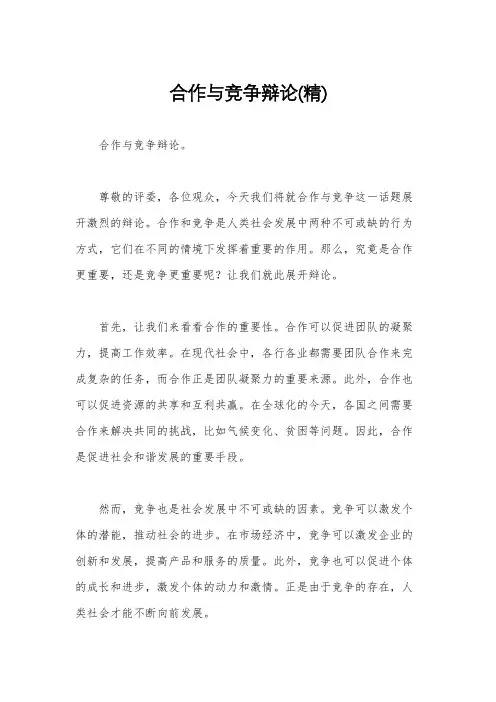
合作与竞争辩论(精)合作与竞争辩论。
尊敬的评委,各位观众,今天我们将就合作与竞争这一话题展开激烈的辩论。
合作和竞争是人类社会发展中两种不可或缺的行为方式,它们在不同的情境下发挥着重要的作用。
那么,究竟是合作更重要,还是竞争更重要呢?让我们就此展开辩论。
首先,让我们来看看合作的重要性。
合作可以促进团队的凝聚力,提高工作效率。
在现代社会中,各行各业都需要团队合作来完成复杂的任务,而合作正是团队凝聚力的重要来源。
此外,合作也可以促进资源的共享和互利共赢。
在全球化的今天,各国之间需要合作来解决共同的挑战,比如气候变化、贫困等问题。
因此,合作是促进社会和谐发展的重要手段。
然而,竞争也是社会发展中不可或缺的因素。
竞争可以激发个体的潜能,推动社会的进步。
在市场经济中,竞争可以激发企业的创新和发展,提高产品和服务的质量。
此外,竞争也可以促进个体的成长和进步,激发个体的动力和激情。
正是由于竞争的存在,人类社会才能不断向前发展。
在这样一个辩题中,我们不得不承认合作和竞争都有其重要性。
然而,我们认为在当今社会,合作更加重要。
在全球化的背景下,各国需要携手合作来解决共同的挑战,而不是相互竞争。
在企业管理中,团队合作和共赢才能推动企业的发展。
因此,我们认为合作是社会发展的主要动力,是推动社会和谐发展的重要手段。
总之,合作和竞争都是社会发展中不可或缺的因素。
然而,在当今社会,合作更加重要,因为它可以促进团队的凝聚力,推动社会的发展。
让我们携手合作,共同推动社会的进步和发展。
谢谢!。
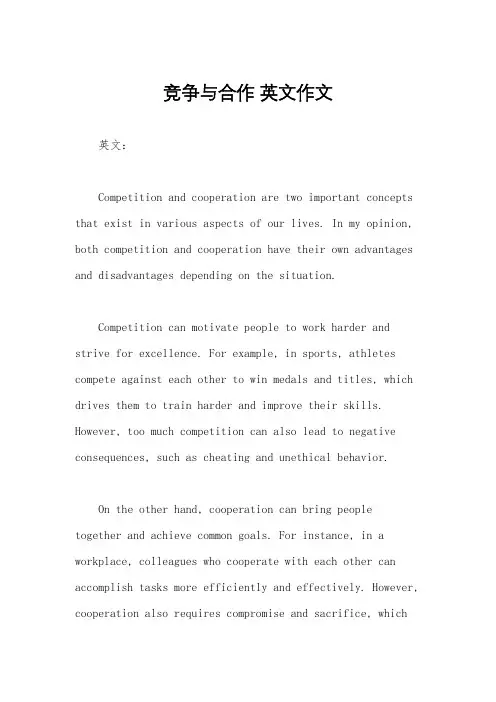
竞争与合作英文作文英文:Competition and cooperation are two important concepts that exist in various aspects of our lives. In my opinion, both competition and cooperation have their own advantages and disadvantages depending on the situation.Competition can motivate people to work harder and strive for excellence. For example, in sports, athletes compete against each other to win medals and titles, which drives them to train harder and improve their skills. However, too much competition can also lead to negative consequences, such as cheating and unethical behavior.On the other hand, cooperation can bring people together and achieve common goals. For instance, in a workplace, colleagues who cooperate with each other can accomplish tasks more efficiently and effectively. However, cooperation also requires compromise and sacrifice, whichmay not always be easy to achieve.Overall, I believe that a balance between competition and cooperation is important. In certain situations, competition can be a driving force for success, while in others, cooperation can lead to greater achievements.中文:竞争和合作是我们生活中各个方面的两个重要概念。
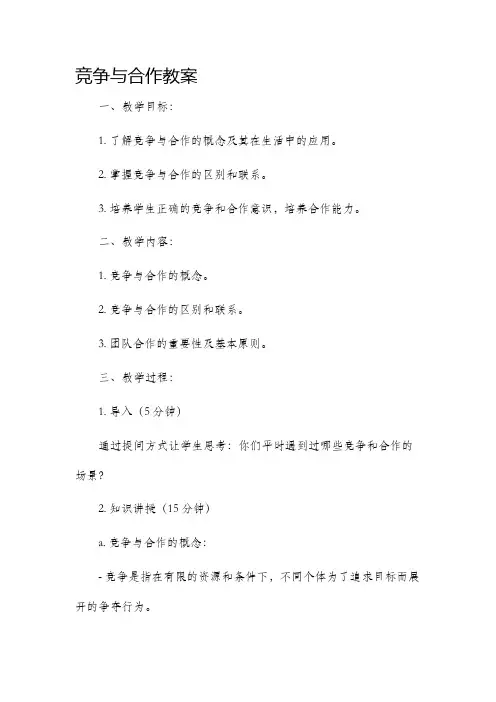
竞争与合作教案一、教学目标:1. 了解竞争与合作的概念及其在生活中的应用。
2. 掌握竞争与合作的区别和联系。
3. 培养学生正确的竞争和合作意识,培养合作能力。
二、教学内容:1. 竞争与合作的概念。
2. 竞争与合作的区别和联系。
3. 团队合作的重要性及基本原则。
三、教学过程:1. 导入(5分钟)通过提问方式让学生思考:你们平时遇到过哪些竞争和合作的场景?2. 知识讲授(15分钟)a. 竞争与合作的概念:- 竞争是指在有限的资源和条件下,不同个体为了追求目标而展开的争夺行为。
- 合作是指为了共同的目标,个体之间共同努力和配合的行为。
b. 竞争与合作的区别和联系:- 区别:竞争注重个体间的自我利益追求,合作强调个体间的协作和团结。
- 联系:在现实生活中,竞争和合作是紧密相连的。
合作中也存在竞争的因素,而竞争中也需要合作来达到更好的效果。
3. 多媒体展示(10分钟)使用PPT或视频的形式展示竞争和合作的例子,让学生直观地感受到竞争与合作的实际应用。
4. 团队合作游戏(20分钟)分组进行团队合作游戏,例如搭积木、接力赛等,让学生通过游戏体验团队合作的重要性和乐趣。
5. 教师点拨(10分钟)总结游戏中的合作经验,引导学生发现竞争和合作在游戏中的作用和意义。
6. 小结(5分钟)通过回答问题的方式,对本节课所学内容进行小结和复习。
四、课堂延伸:在日常生活中,教师可以引导学生了解更多关于竞争与合作的实例,例如体育比赛、学习小组等,让学生将所学应用到实际生活中。
五、作业:布置一篇小作文,要求学生结合自身经历,分享一个体验竞争和合作的事例,以及从中所得到的启示和教训。
六、教学反思:通过本节课的教学,学生们对竞争和合作的概念有了更深入的理解,同时也培养了合作能力。
在团队合作游戏环节中,学生们积极参与,能够感受到团队合作的乐趣和重要性。
以后的教学中,可以通过更多实例和活动来拓展学生对竞争和合作的理解。
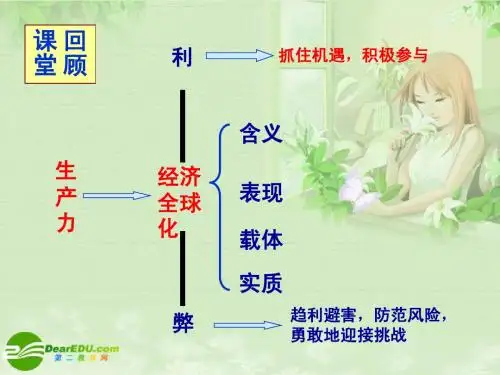
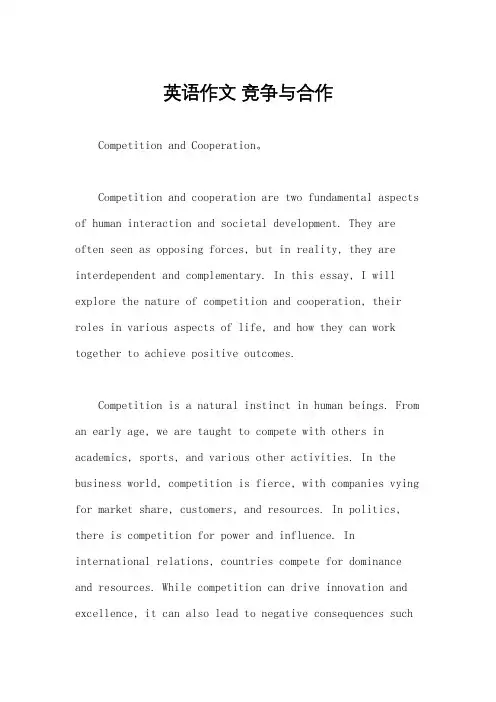
英语作文竞争与合作Competition and Cooperation。
Competition and cooperation are two fundamental aspects of human interaction and societal development. They are often seen as opposing forces, but in reality, they are interdependent and complementary. In this essay, I will explore the nature of competition and cooperation, their roles in various aspects of life, and how they can work together to achieve positive outcomes.Competition is a natural instinct in human beings. From an early age, we are taught to compete with others in academics, sports, and various other activities. In the business world, competition is fierce, with companies vying for market share, customers, and resources. In politics, there is competition for power and influence. In international relations, countries compete for dominance and resources. While competition can drive innovation and excellence, it can also lead to negative consequences suchas cutthroat behavior, unethical practices, and social division.On the other hand, cooperation is essential for the functioning of society. It is through cooperation that individuals and groups work together to achieve common goals. In the workplace, cooperation is necessary for teamwork and productivity. In communities, cooperation is vital for social cohesion and mutual support. In international relations, cooperation is crucial for addressing global challenges such as climate change, poverty, and security threats. While cooperation can lead to harmony and progress, it can also be hindered by selfishness, distrust, and conflicting interests.Despite their differences, competition and cooperation are not mutually exclusive. In fact, they often go hand in hand. In the business world, companies may compete with each other, but they also cooperate through partnerships, alliances, and industry associations. In sports, athletes compete against each other, but they also cooperate within teams and with coaches. In international relations,countries may compete for influence, but they also cooperate on issues of mutual interest through diplomacy, trade, and international organizations.Moreover, competition and cooperation can reinforce each other in positive ways. Healthy competition can motivate individuals and groups to strive for excellence, while cooperation can provide the necessary support and collaboration to achieve success. In the business world, competition can drive innovation and efficiency, while cooperation can lead to shared resources and knowledge. In politics, competition can bring diverse perspectives and choices, while cooperation can lead to consensus and compromise. In international relations, competition can foster national interests and security, while cooperation can lead to peace and prosperity.In conclusion, competition and cooperation are essential elements of human interaction and societal development. While they have distinct characteristics and can lead to both positive and negative outcomes, they are not mutually exclusive and can work together to achievecommon goals. By understanding the nature of competition and cooperation and finding the right balance between the two, we can harness their power to drive progress and create a better world for all.。
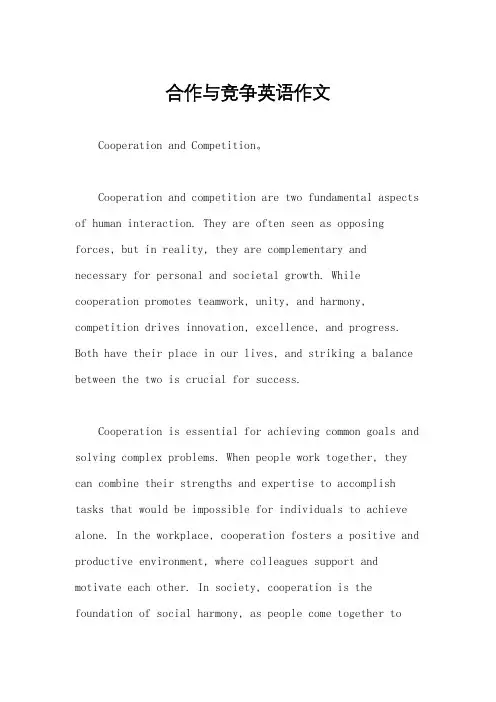
合作与竞争英语作文Cooperation and Competition。
Cooperation and competition are two fundamental aspects of human interaction. They are often seen as opposing forces, but in reality, they are complementary and necessary for personal and societal growth. While cooperation promotes teamwork, unity, and harmony, competition drives innovation, excellence, and progress. Both have their place in our lives, and striking a balance between the two is crucial for success.Cooperation is essential for achieving common goals and solving complex problems. When people work together, they can combine their strengths and expertise to accomplish tasks that would be impossible for individuals to achieve alone. In the workplace, cooperation fosters a positive and productive environment, where colleagues support and motivate each other. In society, cooperation is the foundation of social harmony, as people come together toaddress issues and build a better community.On the other hand, competition fuels ambition and drives individuals and organizations to excel. It pushes people to strive for greatness, to innovate, and to reach their full potential. In the business world, competition forces companies to constantly improve their products and services, benefiting consumers with better choices and quality. In sports, competition brings out the best in athletes, pushing them to break records and achieve new heights of performance.While cooperation and competition have their distinct benefits, they are not mutually exclusive. In fact, they often go hand in hand. In the business world, companies cooperate with each other through partnerships and alliances, while simultaneously competing for market share. In sports, athletes cooperate with their teammates to achieve victory, but they also compete against each other for individual accolades. This duality is evident in many aspects of our lives, and it is the balance between cooperation and competition that drives progress andsuccess.Moreover, striking a balance between cooperation and competition is essential for personal growth and development. In education, students often collaborate on group projects, learning to work as a team and share ideas. However, they also compete for academic achievements, pushing themselves to excel and stand out. This combination of cooperation and competition prepares them for the challenges of the real world, where they will need to collaborate with others while striving to succeed.In conclusion, cooperation and competition are two sides of the same coin, each playing a vital role in our personal and collective growth. By embracing both aspects and finding a balance between them, we can create a society that fosters teamwork, innovation, and excellence. Whether in the workplace, in education, or in our communities, the synergy of cooperation and competition is the key to success.。
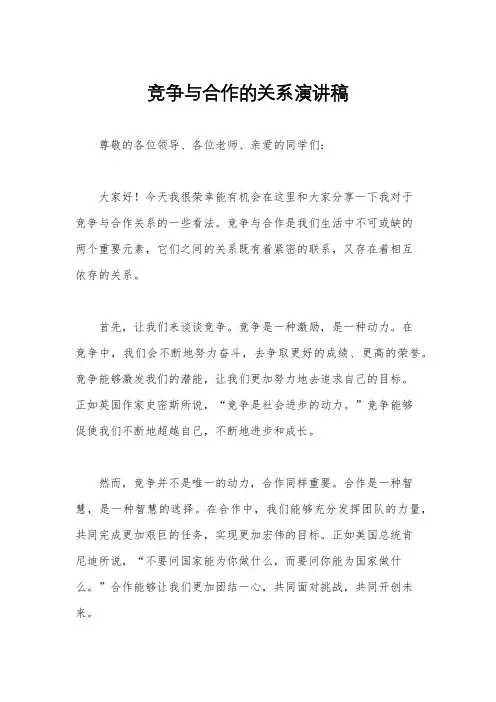
竞争与合作的关系演讲稿尊敬的各位领导、各位老师、亲爱的同学们:大家好!今天我很荣幸能有机会在这里和大家分享一下我对于竞争与合作关系的一些看法。
竞争与合作是我们生活中不可或缺的两个重要元素,它们之间的关系既有着紧密的联系,又存在着相互依存的关系。
首先,让我们来谈谈竞争。
竞争是一种激励,是一种动力。
在竞争中,我们会不断地努力奋斗,去争取更好的成绩、更高的荣誉。
竞争能够激发我们的潜能,让我们更加努力地去追求自己的目标。
正如英国作家史密斯所说,“竞争是社会进步的动力。
”竞争能够促使我们不断地超越自己,不断地进步和成长。
然而,竞争并不是唯一的动力,合作同样重要。
合作是一种智慧,是一种智慧的选择。
在合作中,我们能够充分发挥团队的力量,共同完成更加艰巨的任务,实现更加宏伟的目标。
正如美国总统肯尼迪所说,“不要问国家能为你做什么,而要问你能为国家做什么。
”合作能够让我们更加团结一心,共同面对挑战,共同开创未来。
竞争与合作,看似矛盾,实则相辅相成。
在竞争中,我们要学会尊重对手,学会欣赏对手的优点,从对手身上学到更多的东西。
在合作中,我们要学会倾听他人的意见,学会包容他人的不足,从合作中发现更多的可能。
竞争与合作,不是非此即彼的关系,而是一种相互促进、相互依存的关系。
最后,我想说的是,竞争与合作并不仅仅存在于我们的学习和工作中,它们更是我们人生道路上的两个重要支柱。
在竞争中,我们要保持谦逊和坚韧;在合作中,我们要保持包容和坚持。
只有在竞争与合作的双重推动下,我们才能够不断地成长,不断地进步,走得更远。
谢谢大家!。

一、教学目标1. 让学生理解竞争与合作的关系,认识到竞争与合作既对立又统一,相互渗透,相辅相成。
2. 培养学生具备良好的合作意识与竞争意识,学会在竞争中合作,在合作中竞争。
3. 提高学生的人际交往能力,增强团队协作精神,培养社会适应能力。
二、教学内容1. 竞争与合作的关系2. 竞争与合作的重要性3. 如何在竞争中合作,在合作中竞争4. 培养良好的合作意识与竞争意识三、教学过程1. 导入新课通过一个故事或实例引入竞争与合作的话题,让学生思考竞争与合作之间的关系。
2. 讲解竞争与合作的关系讲解竞争与合作既对立又统一,相互渗透,相辅相成的概念。
通过举例说明,让学生理解在现实生活中,竞争与合作无处不在。
3. 强调竞争与合作的重要性讲解竞争与合作在个人与集体、国家与地区之间的重要性。
通过实例分析,让学生认识到竞争与合作对于个人与集体的发展具有重要意义。
4. 如何在竞争中合作,在合作中竞争讲解在竞争中合作,在合作中竞争的原则与方法。
引导学生正确处理竞争与合作的关系,学会在竞争中互相支持、互相学习,在合作中共同进步。
5. 培养良好的合作意识与竞争意识讲解如何培养良好的合作意识与竞争意识。
引导学生从身边小事做起,参加集体性竞争活动,增强团队协作精神。
6. 总结与反思对本节课的内容进行总结,让学生明确竞争与合作的关系,认识到竞争与合作的重要性。
鼓励学生在日常生活中积极实践,提高自己的竞争与合作能力。
四、教学方法1. 讲授法:讲解竞争与合作的关系、重要性以及如何在竞争中合作,在合作中竞争。
2. 案例分析法:通过实例分析,让学生深入理解竞争与合作的关系。
3. 小组讨论法:引导学生分组讨论,分享彼此的观点与经验,培养团队协作精神。
4. 实践活动法:组织学生参加集体性竞争活动,提高学生的竞争与合作能力。
五、教学评价1. 课堂参与度:观察学生在课堂上的发言与互动,评价学生的参与程度。
2. 小组讨论:评价学生在小组讨论中的表现,包括观点阐述、沟通交流等。

竞争与合作的关系演讲稿尊敬的各位领导、各位老师、亲爱的同学们:大家好!今天我想和大家分享的主题是“竞争与合作的关系”。
竞争与合作是我们生活中不可或缺的两个重要元素,它们之间既有着博弈与角逐,又有着共赢与共同进步。
在现代社会中,我们经常能够看到竞争与合作相互交织,相互促进的场景,这正是人类社会发展的必然要求。
首先,让我们来看看竞争。
竞争是一种激励,是一种动力。
在竞争中,人们会不断挑战自我,追求更高更好的目标,不断超越自己。
竞争激发了人们内在的潜能,推动了社会的发展。
正如莎士比亚所说,“竞争使人们更上一层楼”,竞争让人们不断进步,不断创新,为社会的发展注入了无穷的活力。
然而,竞争并不意味着孤立和对立,相反,合作才是我们实现更大价值的关键。
合作是一种智慧,是一种力量。
在合作中,人们会相互倾听、相互理解,共同解决问题,共同实现目标。
正如古希腊哲学家亚里士多德所说,“整体大于部分之和”,合作让人们团结一致,汇聚力量,共同创造出更加美好的未来。
竞争与合作,看似对立,实则相辅相成。
在竞争中,我们可以学会拼搏、勇敢和坚持;在合作中,我们可以学会包容、倾听和团结。
竞争与合作,就像一对孪生兄弟,一个是阳,一个是阴,缺一不可。
没有竞争,我们可能会停滞不前;没有合作,我们可能会一事无成。
只有竞争与合作相互融合,我们才能在挑战中前行,在合作中共赢。
最后,让我们共同期许,在竞争中保持谦逊,学会尊重对手;在合作中保持坚定,学会分享与奉献。
让我们携手并肩,共同书写竞争与合作的新篇章,共同创造美好的未来!谢谢大家!。
竞争与合作作文竞争与合作。
竞争与合作是人类社会中最基本的两种行为。
竞争是指在有限的资源和机会下,个体或群体为了获得更多的利益而进行的争夺行为;而合作则是指在共同利益的基础上,个体或群体为了实现共同目标而进行的协作行为。
在人类社会的发展过程中,竞争与合作一直都是相互交织、相互制约的两种行为方式,它们既可以促进社会的发展,也可能导致社会的分裂和冲突。
因此,如何正确看待竞争与合作,如何在竞争与合作中找到平衡,已成为当今社会亟待解决的问题。
竞争与合作既是对立的,又是统一的。
在现代社会中,竞争无处不在。
无论是在经济领域,还是在政治领域,竞争都是不可避免的。
在市场经济中,企业之间的竞争激烈,它们为了争夺市场份额,不断推出新产品、降低价格,以吸引更多的消费者。
在政治领域,各个政党之间也是竞争激烈,他们为了争取选民的支持,不断进行政策的辩论和竞争。
而在国际关系中,各个国家之间更是在争夺资源和地盘上展开激烈的竞争。
竞争使得社会充满了活力,推动了社会的发展。
然而,如果竞争过于激烈,就会导致社会的分裂和冲突,甚至可能引发战争。
因此,在竞争中,我们需要懂得合作,寻求共赢的方式,才能实现社会的和谐与稳定。
合作是人类社会发展的重要动力。
在人类社会的进化过程中,合作是人类最基本的生存方式。
人类的祖先在面对自然环境的挑战时,只有通过合作才能获得更多的生存资源。
在现代社会中,合作更是不可或缺的。
在经济领域,企业之间需要合作,才能实现资源的共享和互补,提高生产效率。
在政治领域,政党之间需要合作,才能实现国家的长治久安。
在国际关系中,各个国家更是需要通力合作,才能应对全球性挑战。
因此,合作是推动社会发展的重要力量,只有通过合作,才能实现社会的共同繁荣和进步。
竞争与合作既有对立面,又有统一面。
在现代社会中,我们需要正确看待竞争与合作,找到二者之间的平衡点。
在竞争中,我们需要懂得合作,寻求共赢的方式,才能避免竞争过度激烈导致的社会分裂和冲突。
竞争与合作英语作文Title: The Dynamics of Competition and Cooperation。
Competition and cooperation are two fundamental aspects of human interaction that shape our societies, economies, and relationships. While competition drives innovation and progress, cooperation fosters teamwork and mutual growth.In this essay, we will delve into the dynamics of competition and cooperation, exploring their roles, impacts, and interplay.Firstly, competition serves as a catalyst for growthand improvement. In various aspects of life, whether in sports, academia, or business, competition incentivizes individuals and entities to strive for excellence. It fuels innovation as competitors seek to outdo each other, leading to the development of better products, services, and ideas. Moreover, competition fosters resilience and determination, as individuals face challenges and setbacks, motivatingthem to overcome obstacles and achieve their goals.On the other hand, cooperation plays a crucial role in fostering synergy and collective success. In many endeavors, collaboration among diverse individuals and groupsamplifies strengths and compensates for weaknesses. Through cooperation, people pool their resources, knowledge, and skills to achieve common objectives that may be beyond the reach of individuals acting alone. Teamwork, facilitated by cooperation, enables the accomplishment of complex tasksand the realization of shared aspirations.Interestingly, competition and cooperation are not always mutually exclusive but often coexist in dynamic relationships. In some contexts, healthy competition can spur cooperation as competitors recognize the benefits of collaboration. For example, in the realm of scientific research, competition among laboratories may drive collaboration to tackle grand challenges that require interdisciplinary expertise and resources. Similarly, in business, competing firms may form strategic alliances to enter new markets or develop innovative technologies collectively.Conversely, cooperation can also emerge within competitive environments. Within teams or organizations, individuals may cooperate to outperform rival groups or achieve collective success in competitive settings. Moreover, cooperation often underpins the functioning of competitive systems, such as markets, where firms cooperate with suppliers, distributors, and customers to create value and sustain long-term competitiveness.Despite their potential synergies, competition and cooperation can also give rise to tensions and dilemmas. In competitive environments, there is a risk of excessive rivalry leading to unethical behavior, such as cheating, sabotage, or exploitation. Likewise, in cooperative settings, free-riders or opportunistic behavior may undermine trust and cohesion, eroding the benefits of collaboration. Striking the right balance between competition and cooperation requires careful navigation of incentives, norms, and governance mechanisms to promote fairness, integrity, and mutual respect.In conclusion, competition and cooperation are intertwined forces that shape human endeavors and relationships in diverse domains. While competition drives innovation, growth, and individual achievement, cooperation fosters synergy, teamwork, and collective success. Their dynamic interplay underpins the functioning of societies, economies, and ecosystems, offering opportunities for progress and challenges for governance. By understanding the complexities of competition and cooperation, we can harness their potential to create a more prosperous, equitable, and sustainable world.。
竞争与合作的关系作文英文回答:Competition and cooperation are two sides of the same coin. On one hand, competition drives individuals and organizations to strive for excellence and achieve their goals. It encourages innovation, creativity, and efficiency. On the other hand, cooperation fosters teamwork, trust, and mutual support. It enables individuals and organizations to work together towards a common goal, share resources, and learn from each other.In many cases, competition and cooperation coexist and complement each other. For example, in sports, athletes compete against each other to win, but they also cooperate with their teammates and coaches to improve their skillsand achieve their goals. In business, companies compete for market share and profits, but they also cooperate with suppliers, partners, and customers to create value and achieve success.However, competition and cooperation can also conflict with each other. When competition becomes too intense, it can lead to unethical behavior, cut-throat tactics, and a win-at-all-costs mentality. This can damage relationships, trust, and reputation, and undermine the long-term successof individuals and organizations. On the other hand, when cooperation becomes too passive, it can lead to complacency, mediocrity, and a lack of innovation. This can also hinder the long-term success of individuals and organizations.Therefore, the key to balancing competition and cooperation is to find the right balance between the two.It is important to compete in a fair and ethical manner,and to cooperate in a proactive and constructive way. By doing so, individuals and organizations can achieve their goals, build strong relationships, and contribute to the greater good.中文回答:竞争和合作是同一枚硬币的两面。
产品演示文稿范本文稿一:产品介绍尊敬的各位客户,今天非常荣幸向大家展示我们公司最新推出的产品。
这款产品是经过我们团队精心研发的,旨在满足市场上对高质量、多功能产品的需求。
通过本次演示,我们将为大家展示产品的特点、功能以及优势,希望能够帮助您更好地了解和体验我们的产品。
文稿二:产品特点我们的产品具备以下特点,使其在市场上独具竞争力:1. 先进的技术:我们采用了最先进的技术,确保产品的性能和稳定性。
无论是在速度、精确度还是可靠性方面,我们的产品都能胜任各种高要求的任务。
2. 多功能性:该产品集成了多种功能,能够满足不同行业和需求的用户。
无论是大型企业、中小企业还是个人用户,都能够在我们的产品中找到适合自己的解决方案。
3. 人性化设计:我们对产品的设计始终坚持以用户体验为导向。
从外观到操作界面,我们都力求简洁、易用,让用户能够迅速上手并享受到良好的使用体验。
文稿三:产品功能让我们来看一下该产品的主要功能:1. 功能一:详细描述功能一的特点和优势,以及它对用户的实际价值和帮助。
2. 功能二:进一步介绍功能二,并强调其在行业中的重要性和与竞争产品的区别。
3. 功能三:展示功能三,并重点强调它与其他类似产品的差异化,以及对用户的价值。
文稿四:产品优势我们的产品相比其他竞争对手有以下优势:1. 优势一:强调产品的独特性和创新性,为用户带来更好的使用体验。
2. 优势二:突出产品的高性能和可靠性,使用户能够顺利完成各项任务。
3. 优势三:借势不同功能的融合,使用户在使用产品时能够更加高效、便捷地完成工作。
文稿五:案例分享以下是我们部分客户的使用案例,希望能够给大家提供一些参考:1. 案例一:介绍客户在使用我们产品后取得的实际效果和成果。
2. 案例二:分享另一个客户的成功经验,以及他们对我们产品的好评和信任。
3. 案例三:展示更多客户的案例,以证明产品的广泛适用性和实际效果。
文稿六:服务与支持我们不仅提供优质的产品,更重视与客户的合作与支持:1. 售前支持:在产品选择和购买过程中,我们的销售团队将为客户提供专业的指导和建议。
合作与竞争的关系英语作文Title: The Interplay Between Cooperation and Competition。
Cooperation and competition are two fundamental forces that shape human interactions and drive progress in various aspects of life, from personal relationships to business ventures and international diplomacy. While they may seem like opposing concepts, they are often intertwined, influencing each other in complex ways. In this essay, we will explore the dynamic relationship between cooperation and competition and their significance in different contexts.First and foremost, it is essential to recognize that cooperation and competition are not mutually exclusive; rather, they often coexist and complement each other. In many situations, cooperation lays the groundwork for healthy competition, fostering collaboration and mutual understanding among individuals or groups. For instance, inthe business world, companies may form partnerships or alliances to achieve common goals, such as research and development or market expansion. These collaborativeefforts not only enhance efficiency and innovation but also create a conducive environment for healthy competition, where each party strives to excel while respecting therules of engagement.Conversely, competition can also stimulate cooperation by incentivizing individuals or groups to work together towards shared objectives. In competitive environments, such as sports competitions or academic pursuits, individuals may form teams or study groups to leverage collective strengths and increase their chances of success. This collaborative approach allows participants to pool resources, share knowledge, and support each other, ultimately leading to greater achievements than if they were to act alone.Moreover, cooperation and competition often intersectin social and economic systems, influencing patterns of behavior and decision-making. In societies wherecooperation is valued and incentivized, individuals may prioritize collective welfare over individual gains, leading to the formation of social bonds and the establishment of communal norms. Conversely, in competitive environments where individual success is paramount, cooperation may be perceived as a strategic tool to gain advantages over rivals or to mitigate risks in volatile markets.Furthermore, the relationship between cooperation and competition extends beyond human interactions to thenatural world, where organisms exhibit both cooperative and competitive behaviors to survive and thrive. In ecosystems, species often cooperate through symbiotic relationships or collective hunting strategies to obtain resources or defend against predators. However, they also compete for limited resources such as food, territory, and mates, driving evolutionary adaptations and shaping ecological dynamics over time.In conclusion, cooperation and competition are intertwined forces that play crucial roles in shaping humaninteractions and societal structures. While they may appear as opposing forces, they often complement each other, driving progress and innovation in various domains. Understanding the interplay between cooperation and competition is essential for navigating complex social, economic, and ecological systems, fostering collaboration, and achieving sustainable development in an interconnected world.。